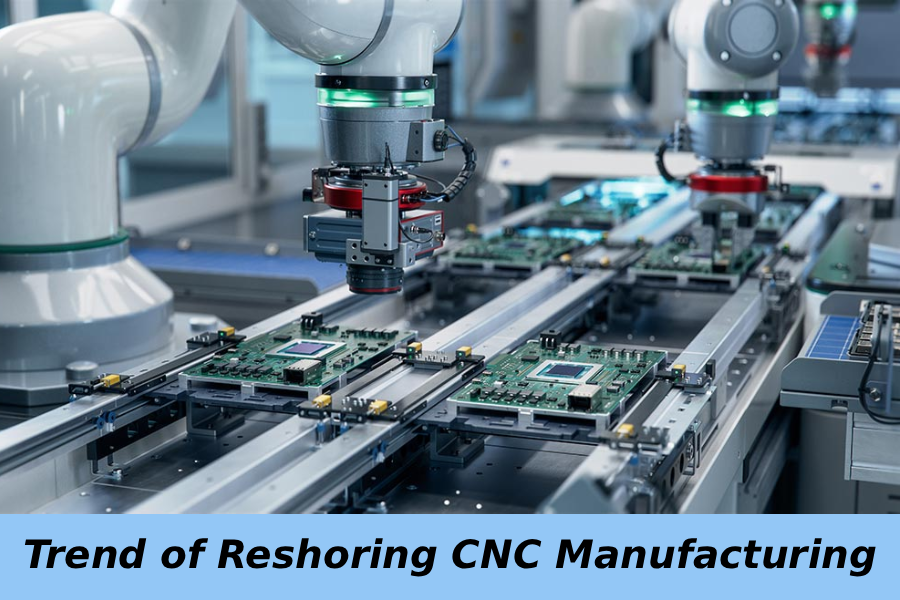The Trend of Reshoring CNC Manufacturing

Reshoring means moving production closer to your customers to cut risk and shorten wait times. For many teams, it can match total cost while improving control and quality. If you buy precision parts or run a shop, the big question is which work to move, when to move it, and how to keep costs in line with CNC Manufacturing best practices. Let’s explore the key drivers behind this reshoring trend and what it means for modern CNC manufacturing.
The Impact of Reshoring on CNC Machining
Reshoring brings machining, finishing, and inspection next to engineering and your end users. That closeness trims transport time, reduces shortages, and speeds feedback on tight‑tolerance parts.
How Reshoring Differs from Nearshoring
Reshoring is returning production to your home market; nearshoring moves it to a nearby country. Both cut lead time and reduce exposure to long ocean freight, but only reshoring gives full domestic control over compliance, service, and change management. Buyers also gain faster design loops, which matter for first‑article approvals and corrective actions. When a tolerance is tight or a finish is tricky, a same‑day shop floor walk beats a multi‑time‑zone call. This speed lowers rework risk and helps teams hold schedule on new launches.
Why Machining And Tooling Lead Early
Precision machining often leads to reshoring waves because quality failures are costly. Complex features, 5‑axis work, and small batches get expensive offshore once you add freight, rejects, and rework. Tooling and fixtures act the same: local sourcing speeds iterations and reduces downtime linked to tool maintenance and changeovers. Shops close to design teams hit PPAP dates faster and protect IP. As a result, high‑mix, lower‑volume families are prime early wins.
Current Reshoring Trends to Watch
Companies are shifting critical parts closer to demand to stabilize schedules and protect margins. Momentum remains strongest in high‑tech and regulated sectors, with facility investments and supplier clusters forming around them.
Where Job Announcements Are Concentrated
Announced projects tend to cluster where logistics, land, and talent align. States with strong training programs and industrial parks attract more suppliers. For machining buyers, these clusters bring tier‑2/3 vendors, heat treaters, and materials distributors within a day’s drive. That proximity supports faster turns on prototypes, PPAPs, and engineering change orders. Over time, a thicker local ecosystem lowers total cost by cutting waiting and transit buffers.
How Shipping, Tariffs, And Risk Changed The Math
Global shocks raised supply chain risk and shifted sourcing models. Uncertain tariffs, port delays, and rate swings add noise to landed quotes. Many teams now value a steady five‑week gain in delivery enough to pay a modest premium because it reduces inventory and expedites. Once you price those hidden costs, local machining often sits closer to parity than the unit price suggests. The math changes again when you count failures caught late at the line.
How Do Total Costs Compare To Offshore Sourcing?
A full Total Cost of Ownership (TCO) view often narrows the gap with offshore. Many buyers still compare only ex‑works or landed cost and miss the real economics.
TCO Vs. Landed Cost
Beyond the PO price, include freight and duties, safety stock, expediting, engineering change costs, supplier management time, defect escape costs, and the cash tied in pipeline stock. For parts with frequent design changes or tight tolerances, local re‑runs and rapid PPAPs can offset higher hourly rates. The faster loop reduces scrap, improves first‑pass yield, and stabilizes schedules. In practice, the total often favors a closer source once you price risk and capital correctly.
Inventory And Quality Escapes
Long supply lines force bigger buffers, which raise carrying costs and hide problems. When issues hit, expedites erase “savings.” Quality escapes at final assembly are costliest of all. Local machining shortens time‑to‑containment and improves quality control through faster gage studies and corrective actions. This is where CNC Manufacturing gains an edge: you can hold tighter windows and keep programs on track without over‑building stock or burning cash.
Offshore vs. Reshored Machining
| Cost Element | Offshore (Typical) | Reshored (Typical) | Hidden Risks | Notes |
| Unit Price | Lower | Higher | Price creep, MOQs | Compare by annualized TCO |
| Freight & Duties | High/variable | Low | Surcharges, delays | Lane‑sensitive and volatile |
| Inventory Carry | High | Lower | Obsolescence | Cash tied in the pipeline |
| Expedites | Episodic, costly | Rare | Premium air | Often ignored in quotes |
| Quality Costs | Remote containment | Faster local | Escape, recalls | Include line‑stop costs |
What Skills And Capacity Gaps Should You Plan For?
Skilled labor is the top bottleneck. You can close it with modern apprenticeships, upskilling, and targeted automation that trims labor per part.
Apprenticeships And Upskilling Paths
Programs that blend classroom learning with shop rotations build programming, setup, and metrology skills fast. Tie training to real jobs and measure capability gains on the floor. Pair junior operators with senior mentors and a clear path to multi‑machine oversight. When the pipeline grows, new lines start smoother and scrap drops early in the curve.
Booking Spindle Time And Realistic Ramps
Secure machine time early, especially for multi‑axis centers and CMM capacity. Plan staged ramps with pilot lots to prove capability, then layer in shifts, cells, or cobots as demand stabilizes. Validate tooling, fixturing, and gage R&R before you commit to volume. This steadies output and keeps promises to customers.
How Does Automation Make CNC Manufacturing Competitive?
Automation, in‑process metrology, and smart planning increase productivity and quality. That makes local CNC Manufacturing cost‑competitive through higher OEE, lower scrap, and faster changeovers.
Lights‑Out CNC Manufacturing With Cobots
Cobots and pallet systems enable lights‑out runs on stable families, freeing skilled talent for setup and programming. Automated probing and SPC tighten process windows and reduce operator touches. When loads are steady and cycle times are predictable, unattended shifts expand capacity without adding headcount. This model turns labor from a fixed limit into a flexible lever.
Digital Planning And APS
Advanced planning and scheduling tools improve promise dates and material timing. Clean master data plus finite scheduling reduces waiting and rework. Teams see better on‑time delivery and fewer expedites when APS is paired with clear routings and real‑time status. The result is a calmer floor and more reliable lead times.
Industries Moving Precision Work Closer
Electronics, electrical equipment, and transportation equipment lead the shift. Medical devices and aerospace also localize critical parts for compliance and quality.
Tight‑Tolerance Parts And Regulated Sectors
Sectors with strict validation and traceability find strong value in local loops. Nearby machining and inspection shorten PPAPs, speed FAIRs, and simplify audits. This is especially true for implants, flight hardware, and power systems, where failure costs are high and documentation is heavy.
Medical, Aerospace, And EV Supply Examples
From orthopedic implants to EV battery components and flight‑critical parts, firms move precision steps closer to engineering. They iterate faster, protect IP, and reduce risk from long lanes. Over time, the nearby base supports better tooling support and faster maintenance cycles, which hold performance steady.
How Should You Build A Reshoring Business Case?
Start with a TCO model, pilot a part family, validate capability, then ramp in phases with automation and skills investment.
Proof of Costs Lead Times Defects
Assemble quotes, historical transit data, expedite logs, defect costs, and cash tied in WIP and stock. Capture change‑order cycle time and inspection yields so you can compare apples to apples. This “evidence pack” supports a clear decision and reduces debate on assumptions. Share it early with finance and operations.
Supplier Audits and Performance KPIs
Run a pilot on one or two SKUs with stable features. Track OTD, FPY, and cost per part. Audit partners for metrology, gage R&R, and corrective action speed. If you need external capacity for prototypes or low volumes, consider a qualified domestic‑ready producer, such as CNC machining services, to shorten the start‑up curve.
What Risks And Trade‑Offs Should Buyers Expect?
Expect policy shifts, demand cycles, and capital timing risks. Use dual sources, staged automation, and flexible cells to hedge while you scale.
Policy Whiplash And Demand Cycles
Reshoring growth varies by sector and can plateau. Keep contracts flexible and revisit your TCO quarterly. Build buffers where changes hit hardest, like special materials or rare processes. If signs turn, you can adjust orders without breaking delivery.
Buy Splits And Dual Sourcing
Keep design-intensive or IP‑sensitive features in‑house. Buy stable subcomponents from trusted partners – dual-source critical parts across domestic and regional suppliers to preserve resilience. Standardize specs and tooling so switching costs stay low.
Why Choose Xmake For US‑Ready CNC Production?
You get fast DFM feedback, precision machining, and scalable capacity with robust checks. That helps you pilot reshoring, validate capability, and ramp with less risk. Contact the Xmake team to discuss manufacturability or begin your quoting process.
Multi‑axis CNC, broad materials, and in‑process inspection shorten lead times while staying inside tight tolerance bands. Clear documentation supports PPAP, FAIR, and traceability needs.
Prototyping to low‑volume production with frequent updates reduces surprises and speeds approvals. Transparent scheduling keeps your launch on time.
Conclusion
Reshoring works when you pick the right parts, calculate true Total Cost of Ownership, and stage capacity with skills and automation. Done well, it offers faster cycles, fewer disruptions, and tighter control over precision outcomes in CNC Manufacturing. Use the TCO model, run a pilot, and build resilience with dual sources. When you’re ready to test a part family or set a ramp plan, a DFM‑first partner like XMAKE can reduce risk and help you hit dates with confidence.
FAQ
What is the difference between reshoring and nearshoring?
Reshoring brings production back to your home country. Nearshoring moves it to a nearby country to cut transit time and risk. Both shorten lead time; reshoring adds domestic control over quality, compliance, and engineering changes.
Does reshoring always raise total cost?
Not when you count Total Cost of Ownership. Freight, duties, safety stock, expedites, late changes, and escape costs narrow the price gap. Many programs reach parity or better once cash tied in pipeline inventory is priced in.
When is nearshoring “good enough” versus full reshoring?
For simple geometries and stable demand, nearshoring can balance cost and speed. For complex 5‑axis parts, strict documentation or rapid ECNs, domestic control usually wins due to faster approvals and containment cycles.



